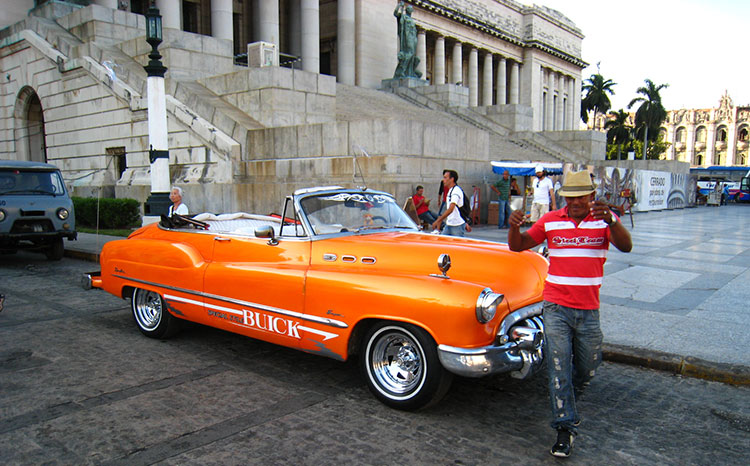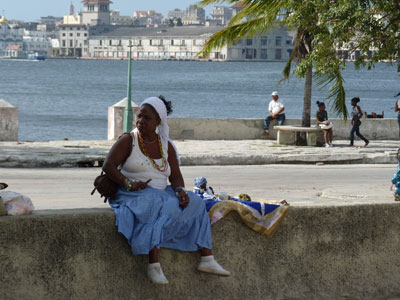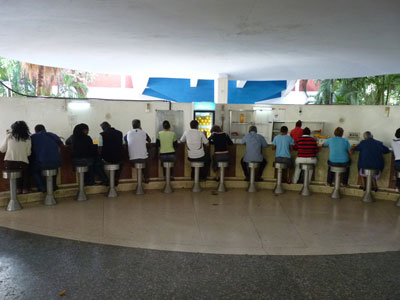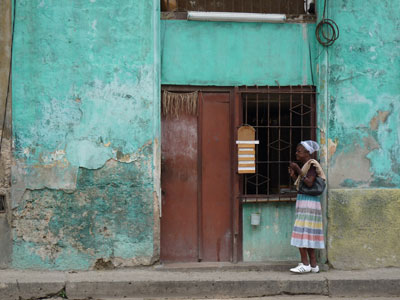Searching the backstreets and boulevards to find the ‘real’ Cuba
This article appears on page 20 of the June 2013 issue.
by Carol Pucci; Seattle, WA
As my husband, Tom, and I got ready to board our Cubana flight to Havana from Cancún, Mexico, the men in line next to us checked in three flat-screen Samsung TV sets and took aboard, as carry-on luggage, a stack of Italian panini presses.
The plane was Soviet made. The snacks were Canadian. We knew we were on our way to Cuba when, once airborne, the flight attendant offered plastic cups of Havana Club rum.
An hour later we landed at the modern, efficient José Martí International Airport. An Immigration agent checked our passports but didn’t stamp them. Then we passed through metal detectors, where a security worker in tight white shorts, a black tank top and white sandals wanded us down. TSA, not!
“Welcome to Cuba,” she said with a smile, and we were in.
First impression
My most lasting memory of this November ’11 trip, my first to Cuba, is riding with a friend in a 1955 cream-colored Chevy taxi on the 4-mile-long Malecón, Havana’s oceanside boulevard, as saltwater splashed over the seawall and “Hotel California” played on the radio.
We were headed to La Coppelia Havana, a sprawling ice-cream emporium that could be mistaken for a slightly run-down amusement park. Built by Fidel Castro in 1966, it was supposed to be Cuba’s answer to Howard Johnson’s.
Everyone there was smiling. Even a wait in line — sometimes two to three hours on busy weekends — turned into a party, with couples kissing, kids playing and strangers striking up conversations.
We watched in awe as our Cuban tablemates ordered 10 plastic dishes of ice cream — 50 scoops in all for about 4¢ each, a grand total of $2.
“Frienemies’’ is what one Cuban jokingly called the few American travelers he’s seen there. Tourism is booming — to the tune of about 2.7 million visitors in 2011 — but because the US government forbids American travelers from visiting Cuba unless they are on educational or cultural tours, it’s mainly Canadians and Europeans filling the hotels and tour buses, sipping mojitos and riding around in the vintage American cars or yellow, open-air, oval taxis called “little eggs.”
Life in Cuba
Because we were traveling on a tour with Global Exchange, which had the required license to operate this tour for professionals doing research, I had the freedom not only to travel with the group but to spend another five days exploring on my own, seeing Cuba as it is, in the ordinary rhythms of life.
A socialist state just 90 miles from Key West, Florida, it’s changing fast as Fidel’s brother, Raúl Castro, attempts to remake a state-controlled economic system that has left its citizens dependent on jobs and subsidies the government can no longer provide.
“Every morning, we wake up and there’s another change,” said our group’s guide, Jesus Noguera, dressed comfortably for Havana’s heat and humidity in sandals, a green polo shirt and khaki shorts.
On that day, it was an announcement that farmers, once they’ve met their quota for providing the government with produce at set prices (often so low, they discourage production), can now sell any surplus directly to hotels and restaurants at whatever price they can get.
This followed news that Cuban residents can buy and sell homes and used cars (previously, only trades were officially permitted) and start many new types of private businesses, including home restaurants, called paladares, and casa particulares, Cuban-style bed-and-breakfasts.
Like most Cubans, Jesus works for a company owned by the state. A single father, he makes, at age 44, the equivalent of about $20 a month — the same as a doctor, teacher or waiter — in return for free medical care, education, nearly free housing and government-subsidized transportation and basic food.
After graduating college, he worked as a social worker, but he later turned to tourism for the same reason many doctors and teachers moonlight as waiters or taxi drivers.
“It’s all about the tips,” he explained as our minibus pulled away for a day of sightseeing in Habana Vieja, the oldest part of the city.
Once a slum, the area is now getting a massive, government-financed makeover aimed at boosting tourism. It was our first lesson in understanding Cuba’s 2-headed economy.
Tourists bring in the hard currency that Cubans need to buy many of the things they want and need. The tips we leave, and most everything we pay for — hotel rooms, taxi fares, meals — are paid in convertible pesos called CUCs (pronounced kooks), each worth approximately $1.
State wages, on the other hand, are paid in Cuban pesos (called CUPs or moneda nacional), with a conversion rate of 25 to $1.
While the national money buys some government-subsidized staples — bad-quality coffee that has been cut with pea flour, for example, plus cooking oil, pizza sold from kitchen windows and cheap, plentiful ice cream at La Coppelia — it’s no substitute for the coveted CUCs.
Bottom line — if you want the best chicken or fish, a Chinese-made washing machine, a cellphone, a computer, a TV, an Internet card or the latest fashions, you have to pay with money the state doesn’t use to pay you.
And you’d better have plenty of it. Because of the US embargo, which prevents Cuba from importing any American-made product or anything made with American parts, these items sell at inflated prices, often higher than they would be in the US or Canada.
A conundrum in a country full of them!
Getting by
What you don’t see in Cuba is as noteworthy as what you do see. There are no billboards, for instance, or signs advertising sales or discounts. No Starbucks. No McDonald’s. Few real stores.
For the average Cuban, “shopping” means lining up outside a darkened booth to buy sugar or cooking oil with ration coupons or, for those with access to dollars, wandering through a cluttered “hard currency” store such as La Distinguida on Calle Obispo, Old Havana’s main shopping street.
The “struggle,” a word that took on special meaning during the revolution that brought Castro to power, continues in new ways.
One day I put together a list of all the ways I saw people trying to make money. I watched a man selling rolls of toilet paper out of a plastic bag. Others were selling peanuts in paper cones, cookies out of buckets or pizzas and pastries from their front windows.
“Leave the tour guide and find your own people to talk to,” wrote blogger Angel Santiesteban on Translatingcuba.com, where a group of American volunteers translate the work of activist Cuban bloggers into English.
“Don’t stay in the hotel swimming pool. Walk along the Malecón and enter the Cuban reality.”
Outside the city
Away from the tour group, Tom and I traveled by bus three hours from Havana to rural Viñales, a UNESCO World Heritage Site known for its national park, limestone cliffs and farms harvesting tobacco and corn.
Scenic hikes and cave explorations awaited, but the best reason to go to Viñales is to do as Angel suggested: get far enough away from the bubble of touristy Havana to experience real life by staying with a family in a casa particular.
We settled into Casa Papo y Niulvys, a peach-colored bungalow with a bright, spacious guest room overlooking a garden on a quiet residential street.
Niulvys, who teaches high-school physics and electronics, was a gracious and talkative hostess. We quickly agreed to let her cook supper for us.
Add a couple of Papo’s predinner mojitos spiked with fresh mint from the garden and we paid around $50 a night for the room, breakfast, drinks and dinner for two.
Niulvys uses her government ration booklet to buy cheap sugar and a few other staples, but for the coffee, pork, chicken or lobster she serves guests, she goes to privately run farmers’ markets or stores and pays in the hard currency she earns from travelers.
Government taxes on the casas are high — $150 per month in low season and $200 in high season, whether or not they have guests every day — but with the income they earn, families are able to buy things they could never otherwise afford. Niulvys and Papo turned a closet into a computer room for their children and recently bought a second air-conditioner for the house.
“It’s difficult,” said Niulvys, who seemed to never stop laughing or smiling. “But we are Cubans. We adapt.”
Centro Habana
For our last few days on our own back in Havana, it was tempting to stay in a historic hotel such as the Ambos Mundos, where Ernest Hemingway wrote in an upstairs room. Instead, we picked out another casa particular, this time in Centro Habana, a gritty neighborhood of crumbling streets and peeling paint where few visitors wander.
Compared to pristine Habana Vieja, Centro is like a rich man who lost all his money and is gradually earning it back.
Many of the buildings are falling apart. Others, built in the late 19th and early 20th centuries, when this part of Havana attracted movie stars and wealthy Americans, house beautifully restored hotels and restaurants.
Sitting one evening on the tiled terrace of the faded Hotel Inglaterra, Tom and I tried to imagine what the French-designed Paseo del Prado promenade was like pre 1959, before Fidel Castro’s revolutionary forces evoked the 03C rule: zero movies, zero shopping, zero nightclubs.
As guests at Casa Colonial Yadilis y Joel, we woke to the sound of a man yelling “¡Pan y mantequilla!” (“Bread and butter!) as he wheeled a large blue box down the street. Why run down the stairs when you can put your money in a basket, lower it on a rope from your balcony and pull up a loaf of fresh bread?
Yadilis’ grandmother left Cuba for the US after the revolution, and for a long while Yadilis wanted her family to join her mother and other relatives living in Miami, but Joel was convinced they could build a future in Havana. He persuaded her to stay and open the casa particular.
They traded houses with the woman next door and spent several years remodeling guest rooms in the 80-year-old walk-up painted bright pink.
For years, Yadilis has longed for the day when it might be possible for her to visit her family in the US. Until recently, however, the only way she could get permission to leave the country was to go without her children, the idea being she wouldn’t be tempted to stay in the US permanently.
Now, with the Cuban government’s lifting such travel restrictions, she is free to plan a long-awaited visit.
When we left, she kissed us good-bye. “When are you coming back?” she asked.
“When are you coming to the United States,” I asked, “with your children?”
She answered without hesitation. “It is my dream.”
Global Exchange (San Francisco, CA: 415/255-7296) offers “Reality Tours” to Cuba targeted at professionals in a number of fields, such as the arts, anthropology, education and the environment. Carol Pucci’s 10-day art-and-architecture tour cost $2,600 per person, including round-trip airfare between Cancún and Havana, hotels, ground transportation and most meals.




